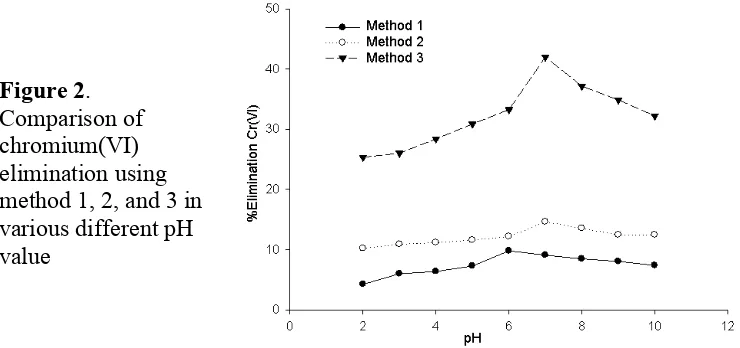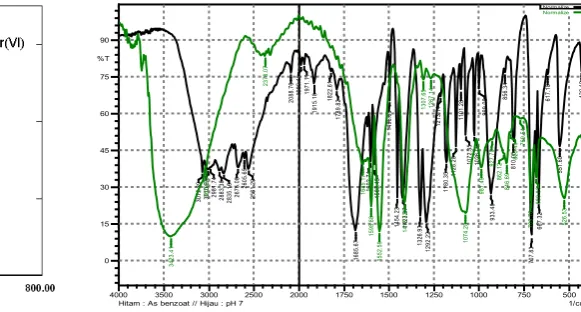The journal homepage www.jpacr.ub.ac.id p-ISSN : 2302 – 4690 | e-ISSN : 2541 – 0733
The Ability of Benzoic Acid to Reduce Cr(VI) Heavy Metal
Content in Aqueous Solution
Anugrah Windy Mustikarini,1* Barlah Rumhayati,1 Chandrawati Cahyani,1,2
1
Departement of Chemistry, Faculty of Sciences, Brawijaya University Jl. Veteran Malang 65145, East Java, Indonesia
2
Chemical Engineering Department, Brawijaya University, Jl. Veteran Malang 65145 Indonesia
*
Corresponding author: [email protected]
Received 30 January 2014; Revised 19 December 2015; Accepted 19 December 2015
ABSTRACT
Chromium (VI) is an ionic heavy metal which has to be handled properly when dissolved in water due to its toxicity, corosive, carsinogenic activity.. According to the State Minister
for Population and Environment’s regulation, the quality standards of waste water, which is allowed to be discharge on surface water contains Cr(VI) is 0.05-1 mg/L. This research used benzoic acid which is a kind of organic acid to reduce Cr(VI) content in water. Benzoic acid has an active carboxyl group which interact this metal. This paper, the elimination of Cr(VI) using benzoic acid is undertaken through pH adjustment by regulating with phosphoric acid. The result showed the best condition to reducing Cr(VI) content 41.99% when 400 ppm of benzoic acid and pH 7 was applied, respectively.
Key word: benzoic acid, adsorption, heavy metal Cr(VI)
INTRODUCTION
Chromium heavy metal was reported causes a human health problems such as lung cancer, chronic ulcer. It was also able to damage the thin membrane of nose. Its main species water soluble of Cr(VI) are H2CrO4, HCrO4-, CrO42- and Cr2O72- [1]. Generally, the source of
chromium pollution in environment from waste water of coating industries, paint factory, ink factory, tanneries, oil refineries, textile mills, and also from ore refining process. Many research have been done to prevent and reduce chromium(VI) content in water such as using bark seed powder to adsorb chromium(VI) in batch and coloumn method [2], and using moringa seed as biofloculant to reduce chromium(VI) level [3], and adsorption using chitosan-alumina [4], chitosan-modified 1,3,5-tribenzoic acid [5], activated carbon [6], metal organic framework (MOF) [7], magnetic lignin [8], chitosan nanoparticle [9], multiwalled carbon nanotube [10], mesoporous magnetic nanosphere [11], hydroxyapatite-cellulose composite [12], mesoporous carbon microsphere [13], Fe-montmorillonite [14], and agricultural biomass [15].
level, the higher percentage of its dissociation. At pH 7, dissociation percentage reaches to 99.86% [17]. And thus, the pH affect to the effectivity of benzoic acid interact to chromium(VI). So that this research use a method by adjusting pH to assess the effectivity of benzoic acid to bind chromium(VI).
EXPERIMENT
Chemicals and instrumentation
Chemicals used are benzoic acid p.a (Merck), sodium hydroxide p.a (Merck), sulfuric acid 98% p.a (Merck), phosphoric acid 85% p.a (Merck), diphenylcarbazide (DPC) 0.25%, potassium chromate (Merck), nitric acid, and aquadest. Meanwhile intrumentation applied for analysis including pH meter (Orion), UV-Vis spectrophotometer (Shimadzu), and FTIR spectrophotometer (Shimadzu).
Procedure reaction
Preparation of Cr(VI) stock solution
A potassium chromate 2.829 g is dissolved with 50 mL of aquadest. This solution was transferred into a 500 ml volumetric flask and adjusted to the limit mark with aquadest. This gave a 1000 ppm of Cr(VI) stock solution.
Preparation of 1000 ppm benzoic acid stock solution
A 1.0 g of benzoic acid is diluted with 50 mL of 5% sodium hydroxide. This is further transferred into a 1.000 mL volumetric flask and diluted up to the limit mark.
The elimination of Cr(VI)
A 25 mL of 25 ppm and pH 2 of Cr(VI) solution (0.625 mg) was mixed with 25 mL of 400 ppm and pH 12 benzoic acid solution. This mixture is stirred, and the pH is adjusted to 2 by addition of sulfuric acid. Its stability is maintained at pH 2 for 5 min. A similar procedure was undertaken to preparing pH of 3, 4, 5, 6, 7, 8, 9, and 10.
The determination of pH effect on the Cr(VI) elimination percentage
Each solution which was obtained from the experiments was centrifuged at 3000 rpm for 20 min. Then, a 1.0 mL was taken and diluted to 25 mL using sulfuric acid until it reach pH 1. Then, it was added 0.5 mL of DPC and left for 9 min. This mixture was measured its absorbance with ultra violet-visible spectrophotometer at a wavelength on 542 nm.
Figure 1. structure of benzoic acid (above) and its infrared spectra
(right) 4000 3500 3000 2500 2000 1750 1500 1250 1000 750 5001/cm
RESULT AND DISCUSSION Benzoic acid analysis
In this research, benzoic acid is used to reduce Cr(VI) metal content in the water. Figure 1 (above) shows infrared spectra of benzoic acid. The characteristic spectrum of benzoic acid is the presence of wide hydroxyl (O-H) absorption appears at 3400-2400 cm-1. This absorption shows a strong hydrogen bonding. Secondly is absorption for carbonyl groups
(C=O) observed at 1685.67 cm-1. Both hydroxyl and carbonyl group belong to the carboxyl
group composed in benzoic acid structure adjacent to the aromatic ring. Meanwhile for C-O group vibration is showed the absorption at 1292.22 cm-1. The absorption due to out of plane bending vibration of O-H field appears at 933.48 cm-1 [18].
The ability of benzoic acid to eliminate Cr(VI) using 3 methods of pH adjustment
This research used 3 methods of pH adjustments for determining the ability of benzoic acid eliminates chromium. For method 1 and 2, the pH adjustment is undergone by applying the pH differences between pH benzoic acid solution (pH 12) and Cr(VI) solution (pH 2). By addition of one solution into another, will change the pH of the mixtured. In method 3, pH was adjusted using sulfuric acid solution. This will lower the pH of mixture resulted. Among these methods, was obtained the graph of correlation of the pH solution and the elimination of Cr(VI). It is showed in Figure 2.
On the first method, the addition process of 400 ppm benzoic acid solution into 25 mL of 25 ppm Cr(VI) is conducted dropwise. Volume of benzoic acid required to raise the pH of the solution mixture from 2 to 3 as much as 1.0 mL with 6.0% elimination (Figure 2). The required volume is relatively small since it was applied 5.0% of sodium hydroxide solution. So that the presence of OH- from base will rapidly increase the pH solution. On method 1, Cr(VI) in solution will be derived first become its species, Cr2O7= and HCrO4- which are
more dominant at pH below 6.5 and CrO42= which is more dominant at pH above 6.5. The
highest Cr(VI) elimination percentage is reached at pH 6 (9.81%). It occur possibly all benzoic acid has not completely dissociated yet. It did not optimally react with Cr(VI) species and resulting a less elimination of Cr(VI).
elimination. The highest elimination of Cr (VI) at pH 7 is 14.62%. This method is less effective because the volume which is used to adjust the pH is excessive. On these both methods, the benzoic acid solution will be set first, while the Cr(VI) which is used as a pH adjustment still in Cr2O7= form. So that when it was added dropwise, the Cr(VI) has not been
completely transformed into its species on each pH level. Therefore, the results obtained were not optimum.
Based on that on figure 2, the third method is considered as the best. Because benzoic acid solution and chromium(VI) solution was set at first, and then it was mixed and the pH was adjusted later. This strategy gives the reaction between benzoic acid and chromium(VI) undergone optimally. At pH 2, 25 mL of 400 ppm benzoic acid eliminated Cr(VI) in 25.36% while at pH 7 recorded at 41.99%, respectively. This method also did not require excessive amount (volume) and has capability much higher eliminate chromium(VI) than that in
The Effect of pH on the elimination of chromium(VI) by benzoic acid
The interaction between benzoic acid and Cr(VI) at pH 7 can be explained spectrometrically by analyzing of the ultraviolet-visible (UV-Vis) and infrared (IR) spectra (Figure 3 and 4). The UV-Vis spectrum (figure 3) shows the interaction between benzoic acid and Cr(VI) species. The maximum wavelength for benzoic acid is recorded at 224.0 nm. It shifted to lower wavelength (219.0 nm) when benzoic acid interact to chromium(VI). This phenomena can be explained that a rising in the strength and in the degree of bond localization (as in the case of toxic heavy metals) or a increasing of polarization of metal bonds with ligand (as in salts of elements belonging to the first group) perturb the uniform distribution of electronic charge in the ring. This brings the decreasing of delocalization energy of π-bond electrons. An increase in differences between the energy of π-bonding orbitals and that of antibonding orbitals leads to a hypsochromic shift of UV-Vis spectra. For example in complex of lead, barium strontium-benzoate appeared in a range between 224 and 223 nm [19].
The infrared analysis results (Figure 4) shows that the interaction of benzoic acid and the species of Cr( VI ) by the shifting of the carbonyl group (C=O) band from 1685.67 cm-1 to 1645.17 cm-1. It is showed as well on C=C aromatic from 1602.74 cm-1 to 1598.88 cm-1 and its vibration stretching loss of C-O carboxyl is 1496.66 cm-1 and 1454.23 cm-1. This is in
line to that reported by Lewandowski (1988) where the metal affected the aromatic system of benzoic acid by shifting the absorption bands [19]. In the IR spectra of the third transition metal group such as Fe(III), Cu(II), and Zn(II) increase the C=C aromatic frequency. Because chromium is a group before Fe(III), it decreases the C=C band frequency of benzoic acid to the lower frequency. The frequency of the Cr, Fe(III), Cu(II), and Zn is 0, 1447, 1448, and 1448 cm-1. The loss of the C=C aromatic absorption Lewandowski study was also occur for heavy metals mercury and lead. This was predicted due to the rate of changing of the electron cloud contained in the aromatic system of benzoic acid is higher than that such was caused by aluminum, calcium, iron, zinc. Moreover, figure 4 is also seen the shifting asymmetry vibration of COO carboxyl from 1583.45 to 1552.98 cm-1 and its symmetry vibrational from 1423.37 to 1413.72 cm-1. The deformation vibration of C=C aromatic group was detected on 1307.65 cm-1 and C-O vibration at 1267.14 cm-1 with very weak intensity.
CONCLUSION
Benzoic acid is effectively used to reduce the chromium(VI) or chromium hexavalent contained in water. The elimination percentage is recorded less than 50%. It is important finding and future study is suggested to explore derivatization of naturally abundant source such as benzoic acid for chromium and other metal toxic adsorption.
REFERENCES
[1] Januarita, R., and Herdiansyah, H., Indones. J. Chem, 2003, 3 (3), 169-175. [2] Aji, B.K., dan Kurniawan, F., Jurnal Sains POMITS, 2012, 1 (1), 1-6.
[3] Mukarromah, L., Efektifitas Bioflokulan Biji Kelor (Moringa oleifera Lamk.) dalam
Mengurangi Kadar Cr(VI), Undergraduate Thesis (Skripsi), Fakultas Sains dan
Teknologi, Universitas Islam Negeri Malang, Indonesia, 2008.
[17] Chipley, J. R., Sodium Benzoate and Benzoic Acid, Antimicrobials in Food, 3rd edition,
2005, CRC Press Taylor & Francis Group, Boca Raton.
[18] Sastrohamidjojo, H., Spektroskopi, 1987, PT Liberty, Yogyakarta.


